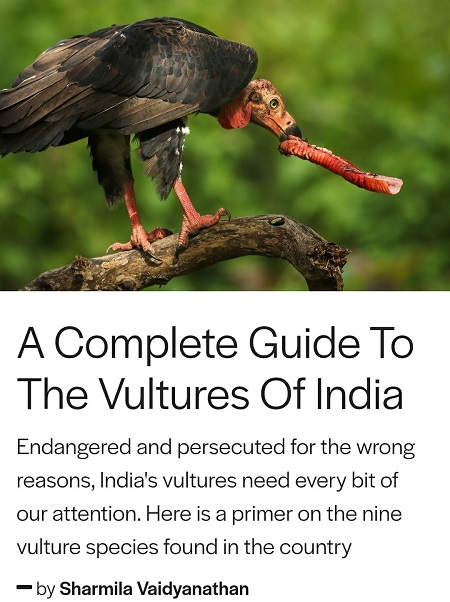Endangered and persecuted for the wrong reasons, India’s vultures need every bit of our attention. Here is a primer on the nine vulture species found in the country.
As published in Nature inFocus on 17 June, 2021. Read the full interview here.
“There have been very few more dramatic, fast and wide scale species declines of any birds or other taxa than those of South Asian Gyps vulture populations since the 1990s.”
– Chris Bowden, Globally Threatened Species Officer, Royal Society For The Protection Of Birds (RSPB), UK (in The Current Threats And Status of Asian Vultures, 2018)
It is quite an alarming statement, but it is the sad truth about the vultures of India. Even today, four of the nine vulture species in India fall under the ‘Critically Endangered’ category in the IUCN Red List of Threatened Species.
Of these nine vulture species, five belong to the genus Gyps while the other four are monotypic. It is estimated that India was home to about four crore vultures in the 1980s. By 2007, their populations plummeted to less than a lakh. A significant reason for this catastrophic decline is the drug diclofenac, a nonsteroidal anti-inflammatory veterinary drug. The drug is toxic to vultures, and they are exposed to it when they feed on animal carcasses that are treated with diclofenac. The relationship between diclofenac and decrease in vulture populations emerged in the mid-nineties, and since then, significant steps have been taken to prevent the usage of this drug. Vultures also face other primary and secondary threats like collision with power lines and electrocution, injury by kite strings during the festival season, and poison baits (usually intended for other wildlife).
The good news is that several conservation efforts are now in place to protect and improve the vulture populations in the country. In 2001, Bombay Natural History Society (BNHS) and the Haryana Forest Department established the Vulture Conservation Breeding Centre (VCBC) in Pinjore, Haryana. The centre is working actively to prevent the extinction of Indian, White-rumped and Slender-billed Vultures. Jorbeer Conservation Reserve in Bikaner, Rajasthan, is a dedicated vulture sanctuary where animal carcasses are dumped so the raptors can feed on them. Across species, vultures visit this ‘vulture restaurant’, thereby gaining access to safe food. BNHS has also worked on protecting Gyps vultures by creating Vulture Safe Zones (VSZ) and increasing awareness about the dangers of using diclofenac. In fact, the Griffon Vulture (Gyps fulvus) is now designated as ‘Least Concern’ by the IUCN. India’s Action Plan for Vulture Conservation 2020-2025 has also laid down various measures, including enhancement of conservation breeding programmes, monitoring populations and setting up of rescue centres.
Head over to Nature inFocus to read the complete story.
